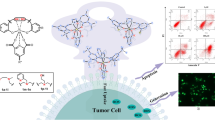Summary
Five ionic cyclopentadienyltitanium(IV) derivatives were investigated for their activity against fluid Ehrlich ascites tumor. Four compounds were built up by the intact bis(cyclopentadienyl)titanium(IV) (“titanocene”) unit, forming the cationic moiety together with two covalently bound ligands, with certain anions being bonded via electrostatic forces: the acetonitrile complex [(C5H5)2TiCl(NCCH3)]+[FeCl4]- (I), the 2,2′-bipyridyl derivative [(C5H5)2Ti(bipy)]2+[CF3SO3]2 (II), the o-phenanthroline complex [(C5H5)2Ti(phen)]2+[CF3SO3]2 (III), and the N-methyl-o-aminothiophenolate derivative {(C5H5)2Ti[o-S(NHCH3)C6H4]}+I- (IV). Another ionic cyclopentadienyltitanium derivative investigated was the five-coordinate bis(dithiolene) chelate [(C5H5)Ti(1,2,4-S2C6H3CH3)2]-[N(C2H5)4]+ (V), the cyclopentadienyltitanium moiety representing the anionic part of the complex salt. All complexes were ionic, salt-like compounds, distinguished by good water solubility. Whereas complexes I, III, and V, given at optimal dose levels, effected maximal cure rates of only 70%–80%, all animals were cured after receiving complexes II and IV at dose ranges of 200–220 and 240–300 mg/kg, respectively. The antitumor activity of complex I was confirmed against solid experimental tumor systems B16 melanoma, colon 38 carcinoma, and Lewis lung carcinosarcoma. Because of their improved solubility in water and pronounced antitumor activity (especially that of II and IV against fluid Ehrlich ascites tumor), ionic cyclopentadienyl titanium complexes are considered to be an interesting new type of antitumor agent.
Similar content being viewed by others
References
Adamson RH, Canellos GP, Sieber SM (1975) Studies on the antitumor activity of gallium nitrate (NSC-15 200) and other group IIIa metal salts. Cancer Chemother Rep 59(1): 599–610
Anghileri LJ (1975) The in vivo inhibition of tumor growth by ruthenium red: its relationship with the metabolism of calcium in the tumor. Z Krebsforsch 83: 213–217
Berners-Price SJ, Mirabelli CF, Johnson RK, Mattern MR, McCabe FL, Fancette LF, Sung CM, Mong SM, Sadler PJ, Crooke ST (1986) In vivo antitumor activity and in vitro cytotoxic properties of bis[1,2-bis(diphenylphosphino)-ethane]gold(I) chloride. Cancer Res 46: 5486–5493
Clarke MJ (1980) The potential of ruthenium in anticancer pharmaceuticals. In: Martell EA (ed) Inorganic chemistry in biology and medicine. ACS, Washington, DC, pp 157–178
Cleare MJ, Hydes PC, Hepburn DR, Malerbi BW (1980) Antitumor platinum complexes: structure-activity relationships. In: Prestayko AW, Crooke ST, Carter SK (eds) Cisplatin-current status and new developments. Academic Press, New York, pp 149–170
Crowe AJ, Smith PJ, Atassi G (1980) Investigations into the antitumour activity of organotin compounds: I. Diorganotin dihalide and di-pseudohalide complexes. Chem Biol Interact 32: 171–178
Elo HO, Lumme PO (1985) Antitumor activity of trans-bis(salicylaldoximato)copper(II): a novel antiproliferative metal complex. Cancer Treat Rep 69: 1021–1022
Keller HJ, Keppler B, Schmähl D (1982) Antitumor activity of cis-dihalogenobis(1-phenyl-1,3-butanediazato)titanium(IV) compounds against Walker 256 carcinosarcoma. Arzneim Forsch/Drug Res 32: 806–807
Keppler BK, Schmähl D (1986) Preclinical evaluation of dichloro-bis(1-phenylbutane-1,3-dionato)titanium(IV)and budotitane. Arzneim Forsch/Drug Res 36: 1822–1828
Köpf H, Köpf-Maier P (1979) Titanocen-dichlorid — das erste Metallocen mit cancerostatischer Wirksamkeit. Angew Chem 91: 509; Angew Chem Int Ed Engl 18: 477–478
Köpf H, Klapötke T (1986) 27-1 (IV)- und-zirconium(IV)-Komplexe mit einem oder zwei Toluol-3,4-dithiolat-Liganden. J Organomet Chem 307: 319–325
Köpf H, Klapötke T, Köpf-Maier P (1986) Titanocene mercaptoanilinium derivatives as new antitumor agents. Proceedings of the 192nd National Meeting of the American Chemical Society, Anaheim, Sept 7–12 (Inorg 0132)
Köpf-Maier P (1985) Tumor inhibition by ferricenium complexes: systemic effect in vivo and cell growth inhibition in vitro. Z naturforsch 40c: 843–846
Köpf-Maier P, Köpf H (1979) Vanadocen-dichlorid — ein weiteres Antitumor-Agens aus der Metallocenreihe. Z Naturforsch 34b: 805–807
Köpf-Maier P, Köpf H (1986) Medical use of cytostatic platinum compounds. In: Gmelin handbook of inorganic chemistry, 8th edn. Springer-Verlag, Berlin, pp 318–338
Köpf-Maier P, Köpf H (1987) Non-platinum-group metal antitumor agents: history, current status, and perspectives. Chem Rev 87: 1137–1152
Köpf-Maier P, Hesse B, Voigtländer R, Köpf H (1980) Tumor inhibition by metallocenes: antitumor activity of titanocene dihalides (C5H5)2TiX2 (X=F,Cl,Br,I,NCS) and their application in buffered solutions as a method for suppressing drug-induced side effects. J Cancer Res Clin Oncol 97: 31–39
Köpf-Maier P, Köpf H, Neuse EW (1984) Ferricenium complexes — a new type of water-soluble antitumor agent. J Cancer Res Clin Oncol 108: 336–340
Köpf-Maier P, Grabowski S, Liegener J, Köpf H (1985) New antitumor titanocene derivatives containing hydrophilic ligands. Inorg Chim Acta 108: 99–103
Kumano N, Nakai Y, Ishikawa T, Koinumari S, Suzuki S, Konno K (1978) Effect of carboxyethylgermanium sesquioxide on the methylcholanthrene-induced tumorigenesis in mice. Sci Rep Res Inst Tohoku Univ [Med] 25: 89–95
Leh FKV, Wolf W (1976) Platinum complexes: a new class of antineoplastic agents. J Pharm Sci 65: 315–328
Meirim MG, Neuse EW (1984) A chlorotitanocene tetrachloroferrate complex stabilized by acetonitrile coordination. Trans Met Chem 9: 337–338
Mulinos MG, Amin P (1980) Toxicology and phase I study of a new anticancer agent, spirogermanium HCI. Fed Am Soc Exp Biol 39: 747
Rosenberg B (1973) Platinum coordination complexes in cancer chemotherapy. Naturwissenschaften 60: 399–406
Rosenberg B (1985) Fundamental studies with cisplatin. Cancer 55: 2303–2316
Rosenberg B, VanCamp L, Trosko JE, Mansour VH (1969) Platinum compounds: a new class of potent antitumour agents. Nature 222: 385–386
Sadler PJ, Nasr M, Narayanan VL (1984) The design of metal complexes as anticancer drugs. Dev Oncol 17: 290–304
Shaw CF III, Beery A, Stocco GC (1986) Anti-tumor activity of two binuclear gold(I) complexes with bridging dithiolate ligands. Inorg Chim Acta 123: 213–216
Thewalt U, Berhalter K (1986) Kattonische Komplexe mit der (η5-C5H5)2TiIV-Baugruppe: Darstellung und Struktur von [η5-C5H5)2Ti(bipy)]2+(CF3SO3 -)2 und [η5-C5H5)2Ti(phen)]2+(CF3SO3 -)2. J Organomet Chem 302: 193–200
Thewalt U, Berhalter K, Neuse EW (1985) The crystal and molecular structure of acetonitrilechlorodicyclopentadienyltitanium tetrachloroferrate(III). Some Mössbauer and X-ray photoelectron spectroscopic data. Trans Met Chem 10: 393–395
Weiss GR, Kisner DL, Kuhn JG, Melink TJ, Meyers JW, Von Hoff DD (1984) New anticancer agents. In: Pinedo HM, Chabner BA (eds) Cancer chemotherapy annual 6. Elsevier, Amsterdam pp 133–162
Author information
Authors and Affiliations
Rights and permissions
About this article
Cite this article
Köpf-Maier, P., Neuse, E., Klapötke, T. et al. Ionic titanocene complexes: a new type of antitumor agent. Cancer Chemother. Pharmacol. 24, 23–27 (1989). https://doi.org/10.1007/BF00254100
Received:
Accepted:
Issue Date:
DOI: https://doi.org/10.1007/BF00254100




